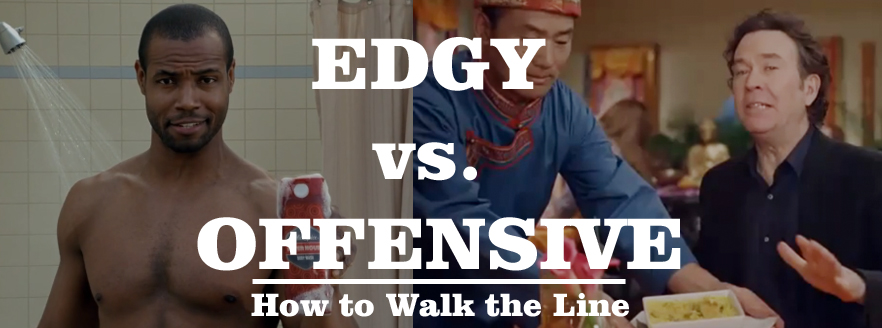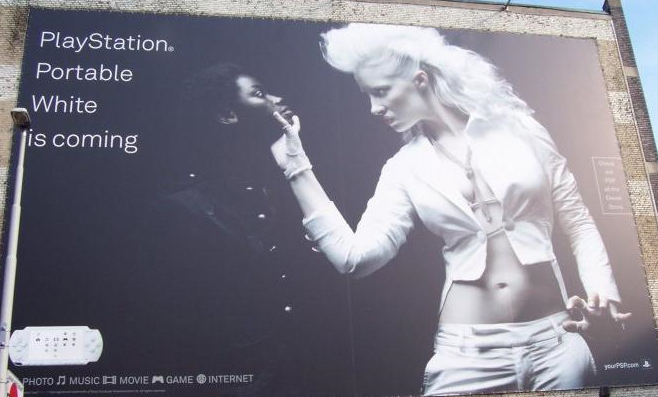
On a planet overstuffed with advertising and marketing messages, sometimes the best way to cut through the clutter is to startle your audience. Like a splash of cold water in the morning, edgy content can wake the masses and build buzz in a truly unique way. But what’s racy to one person may be raunchy to another. What’s offbeat to you may be insensitive to me. Yes, there is a wafer-thin line between edgy and offensive material, and it’s not a line that’s always visible, but if you’re going to approach it, you’d best take a lesson in how to walk it.
Let’s start with the two examples in the graphic above. Now you might think the half naked man in the shower represents the offensive ad here, while the picture of actor Timothy Hutton being served a meal at a restaurant certainly looks safe enough, right? Nope. Isaiah Mustafa’s brilliant run as the “Old Spice Man” struck ad campaign gold, blowing up online and injecting an enormous amount of hipness and relevancy into an 80-year-old company. On paper, the concept of a topless man boasting of his extreme machismo might’ve sounded dicey, but the execution was anything but.
However when Groupon made its first foray into TV advertising — during the 2011 Super Bowl no less — the result was an absolute disaster. The initial 30-second spot featured Hutton making what seemed — at first — to be a plea for the people of Tibet, before somewhat cruelly pulling the rug out.
Just a couple of days after it aired — and drew a tidal wave of complaints — Groupon founder Andrew Mason apologized and pulled the ad.
So what made the Old Spice ad edgy and the Groupon one offensive? Clearly it’s all about context and tone. The Old Spice guy may have shown some skin and implied a superhuman libido, but there was no victim to his shenanigans. Meanwhile, Timothy Hutton seemed to make light of Tibet’s oppression against China’s Communist regime by hawking coupons.
Caution: Hot Topics Inside
OK, so you probably didn’t need us to tell you there are certain subjects that are wise to avoid, but it bears serious repeating. Tackling politics, religion, or race in an ad is rarely a good idea. Sony found that out a couple of years ago with this bizarre billboard for the PSP gaming device.
The risk vs. reward ratio with these hot button issues is so lopsided, it really makes no sense to confront them.
Case closed.
The Problem With “Sex Sells”
The phrase “sex sells’ seems to be almost as old as sex itself; but if taken literally, it’s dead wrong. It should be “sexy sells,” because let’s face it, a pretty face and a great body have been used to market everything from toothpaste to kitchen tile. It’s an annual tradition for GoDaddy to run a pretty raunchy ad during the Super Bowl, and of course that tradition involves the obligatory edits and battles with network censors—somehow we think it’s all part of their PR plan.
http://youtu.be/EQTyxNTQTtk
Is it offensive? It depends on your point of view. But given the fact that their sexy ads generate enormous amounts of publicity and online hype, all without America’s citizenry storming GoDaddy’s doors with pitchforks, we’d have to say these ads are officially in the edgy column.
Ready for the Risk?
Is it better to risk and fail than never to risk at all? Like the examples above, it’s always a judgment call. If you run a blog about office supplies, a provocative photo of a couple with some strategically placed paper clips might very well crush your credibility—or you could find yourself with 3 million new site visitors.
The difference between edgy and offensive will always be a subjective one, but understanding your audience, calculating the risk, and ya know, running your idea by a few people before it’s released to the public—that is how you maintain balance on a very thin line.

